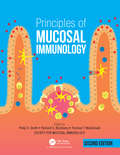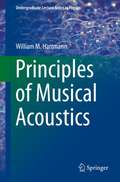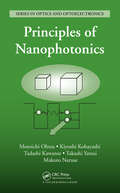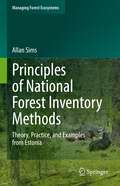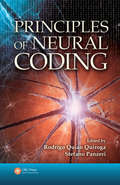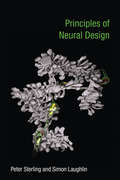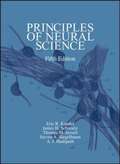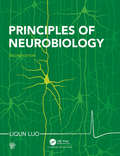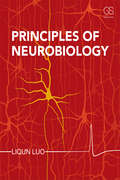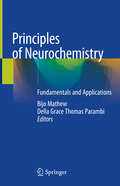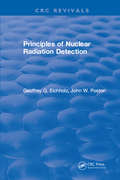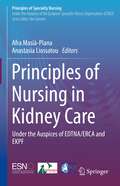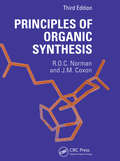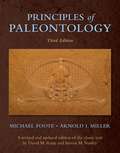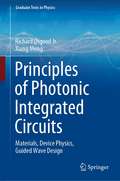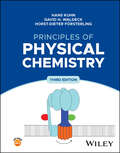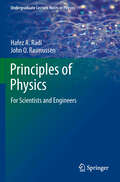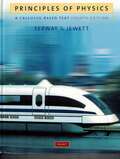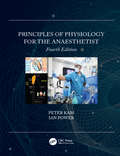- Table View
- List View
Principles of Mucosal Immunology
by Phillip D. Smith, Richard S. Blumberg and Thomas T. MacdonaldThis respected graduate-level textbook provides comprehensive and accessible coverage of the basic and clinical aspects of the mucosal immune system, addressing the major components of the mucosal barrier ̶ gastrointestinal, upper and lower respiratory, ocular, and genitourinary mucosal immune systems ̶ in a highly user-friendly style. The editors of and contributors to the book, all internationally-recognized leaders, present the current principles, concepts, and basic processes involved in mucosal immunology, mucosal diseases, and host defense at mucosal surfaces. Topics discussed include the development and structure of the mucosal immune system and its cellular constituents, host-microbe relationships, infection, mucosal diseases, and vaccines. The second edition has been carefully updated throughout to reflect the latest developments from clinical research and key literature has been fully updated.
Principles of Musical Acoustics (Undergraduate Lecture Notes in Physics)
by William M. HartmannPrinciples of Musical Acoustics focuses on the basic principles in the science and technology of music. Musical examples and specific musical instruments demonstrate the principles. The book begins with a study of vibrations and waves, in that order. These topics constitute the basic physical properties of sound, one of two pillars supporting the science of musical acoustics. The second pillar is the human element, the physiological and psychological aspects of acoustical science. The perceptual topics include loudness, pitch, tone color, and localization of sound. With these two pillars in place, it is possible to go in a variety of directions. The book treats in turn, the topics of room acoustics, audio both analog and digital, broadcasting, and speech. It ends with chapters on the traditional musical instruments, organized by family. The mathematical level of this book assumes that the reader is familiar with elementary algebra. Trigonometric functions, logarithms and powers also appear in the book, but computational techniques are included as these concepts are introduced, and there is further technical help in appendices.
Principles of Nano-optics
by Lukas Novotny Bert HechtFirst published in 2006, this book has become the standard reference on nano-optics. Now in its second edition, the text has been thoroughly updated to take into account new developments and research directions. While the overall structure and pedagogical style of the book remain unchanged, all existing chapters have been expanded and a new chapter has been added. Adopting a broad perspective, the authors provide a detailed overview of the theoretical and experimental concepts that are needed to understand and work in nano-optics, across subfields ranging from quantum optics to biophysics. New topics of discussion include: optical antennas; new imaging techniques; Fano interference and strong coupling; reciprocity; metamaterials; and cavity optomechanics. With numerous end-of-chapter problem sets and illustrative material to expand on ideas discussed in the main text, this is an ideal textbook for graduate students entering the field. It is also a valuable reference for researchers and course teachers.
Principles of Nanophotonics (Series in Optics and Optoelectronics)
by Kiyoshi Kobayashi Motoichi Ohtsu Takashi Yatsui Makoto Naruse Tadashi KawazoeCoauthored by the developer of nanophotonics,this book outlines physically intuitive concepts of the subject using a novel theoretical framework that differs from conventional wave optics. After reviewing the background, history, and current status of research and development in nanophotonics and related technologies, the authors present a unique theoretical model to describe the interactions among nanometric material systems via optical near-fields. They then explore nanophotonic devices and fabrication techniques and provide examples of qualitative innovation. The final chapter looks at how the assembly of nanophotonic devices produces a nanophotonic system.
Principles of National Forest Inventory Methods: Theory, Practice, and Examples from Estonia (Managing Forest Ecosystems #43)
by Allan SimsThis Monograph explains the statistical theory behind the National Forest Inventory (NFI) data collection and compares different methods for modelling and inventory design. The author also explains how natural uncertainty in measurement and modelling can affects the results. Forests, as dynamic systems, are influenced by many unpredictable factors over time. Therefore, readers can use this book to develop the right framework of expectations, when using NFI data. The chapters give an outlook on traditional methods like sample plots, but also consider newer approaches like remote sensing. By merging these different techniqes, NFI datasets can become more reliable and facetted. One of the most contemporary developments in the field, is the use of continuous plots that offer live data at all times. Whether this data should be open to the public, is another discussion point that the author addresses. Offering a perspective from Estonia, readers will find practical examples for all discussed methods. This bridge from theory to practice, makes the volume a useful resource for scientists and decision makers in the forestry sector.
Principles of Neural Coding
by Rodrigo Quian Quiroga Stefano PanzeriUnderstanding how populations of neurons encode information is the challenge faced by researchers in the field of neural coding. Focusing on the many mysteries and marvels of the mind has prompted a prominent team of experts in the field to put their heads together and fire up a book on the subject. Simply titled Principles of Neural Coding, this b
Principles of Neural Design (The MIT Press Series)
by Peter Sterling Simon LaughlinTwo distinguished neuroscientists distil general principles from more than a century of scientific study, “reverse engineering” the brain to understand its design.
Principles of Neural Science, Fifth Edition
by Eric R. Kandel James H. Schwartz Thomas M. Jessell Steven A. Siegelbaum A. J. HudspethUltimately, Principles of Neural Science affirms that all behavior is an expression of neural activity, and that the future of clinical neurology and psychiatry hinges on the progress of neural science. Far exceeding the scope and scholarship of similar texts, this unmatched guide offers a commanding, scientifically rigorous perspective on the molecular mechanisms of neural function and disease―one that you’ll continually rely on to advance your comprehension of brain, mind, and behavior.
Principles of Neurobiology
by Liqun LuoPrinciples of Neurobiology, Second Edition presents the major concepts of neuroscience with an emphasis on how we know what we know. The text is organized around a series of key experiments to illustrate how scientific progress is made and helps upper-level undergraduate and graduate students discover the relevant primary literature. Written by a single author in a clear and consistent writing style, each topic builds in complexity from electrophysiology to molecular genetics to systems level in a highly integrative approach. Students can fully engage with the content via thematically linked chapters and will be able to read the book in its entirety in a semester-long course. Principles of Neurobiology is accompanied by a rich package of online student and instructor resources including animations, figures in PowerPoint, and a Question Bank for adopting instructors.
Principles of Neurobiology
by Liqun LuoPrinciples of Neurobiology presents the major concepts of neuroscience with an emphasis on how we know what we know. The text is organized around a series of key experiments to illustrate how scientific progress is made and helps upper-level undergraduate and graduate students discover the relevant primary literature. Written by a single author in
Principles of Neurochemistry: Fundamentals and Applications
by Bijo Mathew Della Grace Thomas ParambiThis book provides medical professionals and researchers with a comprehensive overview of fundamental concepts and recent advances in neurochemistry, and offers new perspectives for all those involved with research in related disciplines. As drug discovery for neurodegenerative diseases is one of the largest subspecialties in the field of medicine, the book addresses topics that transcend the borders between disciplines, and presents a wealth of investigations into and discussions on critical questions relevant to the entire field of CNS drug research. It summarizes the available data on the fundamentals of neurotransmitters, treatment of and advanced care for neurodegenerative diseases; and outlines current and future research directions in this field. Combining both conventional and innovative approaches to the topic, the book offers a valuable guide for readers working in medicinal chemistry, the life sciences and allied fields.
Principles of Nuclear Radiation Detection
by Geoffrey G. EichholzThis book is intended for senior undergraduate and beginning graduate students in physics, nuclear engineering, health physics and nuclear medicine, and for specialized training courses for radiation protection personnel and environmental safety engineers.To keep the size of the book manageable, material has been selected to stress those detectors that are in widespread use. Attempts have also been made to emphasize alternatives available in approaching various measurement problems and to present the criteria by which a choice among these alternatives may be made.
Principles of Nursing in Kidney Care: Under the Auspices of EDTNA/ERCA and EKPF (Principles of Specialty Nursing)
by Afra Masià-Plana Anastasia LiossatouThis textbook, endorsed by EDTNA/ERCA and ESNO, provides unique evidence-based knowledge about nursing in renal care and harmonises specialised understandings from various countries, to be implemented across numerous national health systems. Renal care nursing is essential in order to promote and prevent renal health as well as detect and contribute to the care of renal disease. These complex tasks require specialised knowledge and training to ensure patient safety and positive outcomes in patient care. This book describes in detail the highest quality practices in different stages of the disease. Twenty-three chapters reflect evidence-based or consensus in practise, covering management and treatment in patient centred care procedures. Combining expert knowledge from many countries, this textbook can be used for teaching new staff in renal care as well as reviewing and updating renal care expertise. Technological developments have significantly expanded in recent years. In this context renal nurses are responsible not only for individualised, comprehensive, and complex patient care, but also advanced technical skills such as haemodialysis treatment, which require close monitoring of patients to ensure safety. Infection prevention and control is vital throughout patient care. In addition, advanced renal nursing skills have been established for the assessment and management of renal disease. The textbook is unique as in one single volume there is evidence, up to date and rigorous data describing different types of renal care therefore it is possible to concept a holistic vision of CKD patients as well as the nursing perspective.
Principles of Optics
by Max Born Emil WolfPrinciples of Optics is one of the classic science books of the twentieth century, and probably the most influential book in optics published in the past 40 years. The new edition is the first ever thoroughly revised and expanded edition of this standard text. Among the new material, much of which is not available in any other optics text, is a section on the CAT scan (computerized axial tomography), which has revolutionized medical diagnostics. The book also includes a new chapter on scattering from inhomogeneous media which provides a comprehensive treatment of the theory of scattering of scalar as well as of electromagnetic waves, including the Born series and the Rytov series. The chapter also presents an account of the principles of diffraction tomography - a refinement of the CAT scan - to which Emil Wolf, one of the authors, has made a basic contribution by formulating in 1969 what is generally regarded to be the basic theorem in this field. The chapter also includes an account of scattering from periodic potentials and its connection to the classic subject of determining the structure of crystals from X-ray diffraction experiments, including accounts of von Laue equations, Bragg's law, the Ewald sphere of reflection and the Ewald limiting sphere, both generalized to continuous media. These topics, although originally introduced in connection with the theory of X-ray diffraction by crystals, have since become of considerable relevance to optics, for example in connection with deep holograms. Other new topics covered in this new edition include interference with broad-band light, which introduces the reader to an important phenomenon discovered relatively recently by Emil Wolf, namely the generation of shifts of spectral lines and other modifications of spectra of radiated fields due to the state of coherence of a source. There is also a section on the so-called Rayleigh-Sommerfield diffraction theory which, in recent times, has been finding increasing popularity among optical scientists. There are also several new appendices, including one on energy conservation in scalar wavefields, which is seldom discussed in books on optics. The new edition of this standard reference will continue to be invaluable to advanced undergraduates, graduate students and researchers working in most areas of optics.
Principles of Optics for Engineers
by Chang, William S. C.Uniting classical and modern photonics approaches by presenting optical analyses as solutions of Maxwell's equations, this unique book enables students and practising engineers to fully understand the similarities and differences between the different methods. The book begins with a thorough discussion of plane wave analysis, which provides a clear understanding of optics without considering boundary condition or device configuration. It then goes on to cover diffraction analysis of many applications, including a rigorous analysis of TEM waves using Maxwell's equations with boundaries. Laser cavity modes and Gaussian beams are presented, modal analysis is covered, and approximation methods are discussed (including the perturbation technique, coupled mode analysis, and super mode analysis). With theory linked to practical examples throughout, it provides a clear understanding of the interplay between plane wave, diffraction and modal analysis, and how the different techniques can be applied to various areas including imaging, signal processing, and optoelectronic devices.
Principles of Optics: 60th Anniversary Edition
by Max Born Emil WolfPrinciples of Optics is one of the most highly cited and most influential physics books ever published, and one of the classic science books of the twentieth century. To celebrate the 60th anniversary of this remarkable book's first publication, the seventh expanded edition has been reprinted with a special foreword by Sir Peter Knight. The seventh edition was the first thorough revision and expansion of this definitive text. Amongst the material introduced in the seventh edition is a section on CAT scans, a chapter on scattering from inhomogeneous media, including an account of the principles of diffraction tomography, an account of scattering from periodic potentials, and a section on the so-called Rayleigh–Sommerfield diffraction theory. This expansive and timeless book continues to be invaluable to advanced undergraduates, graduate students and researchers working in all areas of optics.
Principles of Organic Synthesis, 3rd Edition
by Richard O.C. NormanThis book is designed for those who have had no more than a brief introduction to organic chemistry and who require a broad understanding of the subject. The book is in two parts. In Part I, reaction mechanism is set in its wider context of the basic principles and concepts that underlie chemical reactions: chemical thermodynamics, structural theory, theories of reaction kinetics, mechanism itself and stereochemistry. In Part II these principles and concepts are applied to the formation of particular types of bonds, groupings, and compounds. The final chapter in Part II describes the planning and detailed execution of the multi-step syntheses of several complex, naturally occurring compounds.
Principles of Paleontology, Third Edition
by Michael Foote Arnold I. MillerWhen published in 1971, Principles of Paleontology (POP) by David Raup and Steven Stanley revolutionized both textbooks and teaching in paleontology by adopting an approach that focused on the process of studying biologic groups, rather than a systematic approach (the study of individual groups of organisms), or an historical approach (narrating events to date). For this highly anticipated revision of Raup and Stanley’s one-term undergraduate text, two of Raup’s former students―Michael Foote and Arnold Miller―use that defining core approach to present a thoroughly up-to-date portrait of a field that has undergone major transformations in the last two decades.
Principles of Photonic Integrated Circuits: Materials, Device Physics, Guided Wave Design (Graduate Texts in Physics)
by Richard Osgood jr. Xiang MengThis graduate-level textbook presents the principles, design methods, simulation, and materials of photonic circuits. It provides state-of-the-art examples of silicon, indium phosphide, and other materials frequently used in these circuits, and includes a thorough discussion of all major types of devices. In addition, the book discusses the integrated photonic circuits (chips) that are currently increasingly employed on the international technology market in connection with short-range and long-range data communication. Featuring references from the latest research in the field, as well as chapter-end summaries and problem sets, Principles of Photonic Integrated Circuits is ideal for any graduate-level course on integrated photonics, or optical technology and communication.
Principles of Physical Chemistry
by Hans Kuhn Horst-Dieter Försterling David H. WaldeckCore textbook showcasing the broad scope and coherence of physical chemistry Principles of Physical Chemistry introduces undergraduate students to the concepts and methods of physical chemistry, which are fundamental to all of Chemistry. In their unique approach, the authors guide students along a logically consistent pathway from the principles of quantum mechanics and molecular structure to the properties of ensembles and supramolecular machines, with many examples from biology and nanoscience. By systematically proceeding from atoms to increasingly complex forms of matter, the book elucidates the connection between recognizable paradigms and modern chemistry research in a student-friendly manner. To promote intuition and understanding for beginning students, the text introduces concepts before proceeding to more rigorous treatments. Rigorous proofs and derivations are provided, as electronic supplements, for more advanced students. The book poses over 900 exercises and problems to help the student learn and master methods for physicochemical reasoning. Computational supplementary material, including Fortran simulations, MathCAD exercises, and Mathematica programs, are included on a companion website. Some topics discussed in the text are: Electronic structure and Variational Principle, including Pauli exclusion, spin-orbit interactions, and electron confinement in quantum dots.Chemical bonding and molecular structure, including electron tunneling, comparison of electron-in-a-box models and electron orbital methods, and the mechanics of chemical bonds.Absorption and emission of light, including transition dipoles for π-electron systems, coupled chromophores, excitons, and chiroptical activity.Statistical description of molecular ensembles, including microscopic interpretations of phase transitions, entropy, work, and heat.Chemical equilibria, including statistical description of equilibrium constants, electrochemistry, and the exposition of fundamental reaction types.Reaction kinetics and reaction dynamics, including nonlinear coupled reactions, femtochemistry, and solvent effects on reactions.Physicochemical properties of macromolecules and the principles of supramolecular assemblies, including polymer dynamics and chemical control of interfaces. The logic of supramolecular machines and their manipulation of photon, electron, and nuclear motion. With its highly coherent and systematic approach to the subject, Principles of Physical Chemistry is an ideal textbook and resource for students in undergraduate physical chemistry courses, especially those in programs of study related to chemistry, engineering, and molecular and chemical biology.
Principles of Physics
by Hafez A Radi John O RasmussenThis textbook presents a basic course in physics to teach mechanics, mechanical properties of matter, thermal properties of matter, elementary thermodynamics, electrodynamics, electricity, magnetism, light and optics and sound. It includes simple mathematical approaches to each physical principle, and all examples and exercises are selected carefully to reinforce each chapter. In addition, answers to all exercises are included that should ultimately help solidify the concepts in the minds of the students and increase their confidence in the subject. Many boxed features are used to separate the examples from the text and to highlight some important physical outcomes and rules. The appendices are chosen in such a way that all basic simple conversion factors, basic rules and formulas, basic rules of differentiation and integration can be viewed quickly, helping student to understand the elementary mathematical steps used for solving the examples and exercises. Instructors teaching form this textbook will be able to gain online access to the solutions manual which provides step-by-step solutions to all exercises contained in the book. The solutions manual also contains many tips, colored illustrations, and explanations on how the solutions were derived.
Principles of Physics: A Calculus-Based Text
by Raymond A. Serway John W. JewettThis successful text was the first to address the latest teaching and learning trends as suggested by the Introductory University Physics Project (IUPP) guidelines. PRINCIPLES OF PHYSICS features a concise approach to traditional topics, an early introduction to modern physics, integration of physics education research pedagogies, as well as the integration of contemporary topics throughout the text. This revision of PRINCIPLES OF PHYSICS also contains text/media integration unlike no other through the PhysicsNow online assessment, tutorial, and course management system.
Principles of Physics: For Scientists and Engineers (Undergraduate Lecture Notes in Physics)
by Hafez A Radi John O RasmussenThis textbook presents a basic course in physics to teach mechanics, mechanical properties of matter, thermal properties of matter, elementary thermodynamics, electrodynamics, electricity, magnetism, light and optics and sound. It includes simple mathematical approaches to each physical principle, and all examples and exercises are selected carefully to reinforce each chapter. In addition, answers to all exercises are included that should ultimately help solidify the concepts in the minds of the students and increase their confidence in the subject. Many boxed features are used to separate the examples from the text and to highlight some important physical outcomes and rules. The appendices are chosen in such a way that all basic simple conversion factors, basic rules and formulas, basic rules of differentiation and integration can be viewed quickly, helping student to understand the elementary mathematical steps used for solving the examples and exercises.Instructors teaching form this textbook will be able to gain online access to the solutions manual which provides step-by-step solutions to all exercises contained in the book. The solutions manual also contains many tips, coloured illustrations, and explanations on how the solutions were derived.
Principles of Physiology for the Anaesthetist
by Peter Kam Ian PowerThis book provides readers with an anaesthesia-focused alternative to general physiology textbooks. The new edition has been reorganised with the trainee anaesthesist in mind, into shorter bite-sized chapters ideal for exam revision. The content includes the physiology of all major organ systems, with specific emphasis on the nervous, respiratory, and cardiovascular systems as well as special sections on pain, aging, specific environments and obesity. Alongside the learning objectives, reflection points and a handy summary of physiological equations and tables, there is greater emphasis on clinical application in this fourth edition, with applied physiology included in almost every section.
Principles of Planetary Climate
by Raymond T. PierrehumbertThis book introduces the reader to all the basic physical building blocks of climate needed to understand the present and past climate of Earth, the climates of Solar System planets, and the climates of extrasolar planets. These building blocks include thermodynamics, infrared radiative transfer, scattering, surface heat transfer and various processes governing the evolution of atmospheric composition. Nearly four hundred problems are supplied to help consolidate the reader's understanding, and to lead the reader towards original research on planetary climate. This textbook is invaluable for advanced undergraduate or beginning graduate students in atmospheric science, Earth and planetary science, astrobiology, and physics. It also provides a superb reference text for researchers in these subjects, and is very suitable for academic researchers trained in physics or chemistry who wish to rapidly gain enough background to participate in the excitement of the new research opportunities opening in planetary climate.
